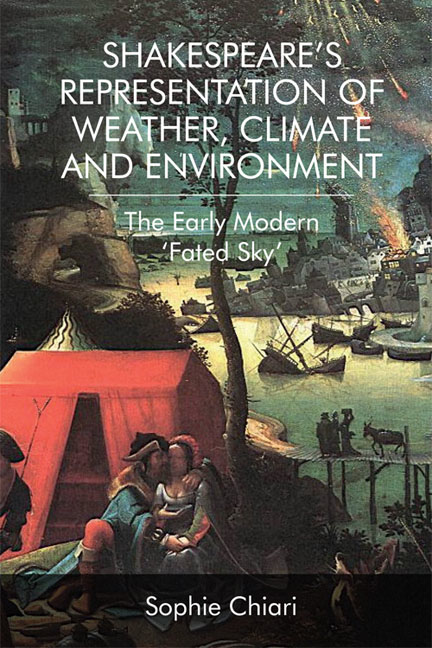Book contents
- Frontmatter
- Contents
- Illustrations
- Acknowledgements
- Textual Note
- Introduction
- 1 ‘We see / The seasons alter’: Climate Change in A Midsummer Night's Dream
- 2 ‘[T]he fire is grown too hot!’: Romeo and Juliet and the Dog Days
- 3 ‘Winter and rough weather’: Arden's Sterile Climate
- 4 Othello: Shakespeare's À bout de souffle
- 5 ‘The pelting of [a] pitiless storm’: Thunder and Lightning in King Lear
- 6 Clime and Slime in Anthony and Cleopatra
- 7 The I/Eye of the Storm: Prospero's Tempest
- Conclusion: ‘Under heaven's eye’
- Bibliography
- Index
6 - Clime and Slime in Anthony and Cleopatra
- Frontmatter
- Contents
- Illustrations
- Acknowledgements
- Textual Note
- Introduction
- 1 ‘We see / The seasons alter’: Climate Change in A Midsummer Night's Dream
- 2 ‘[T]he fire is grown too hot!’: Romeo and Juliet and the Dog Days
- 3 ‘Winter and rough weather’: Arden's Sterile Climate
- 4 Othello: Shakespeare's À bout de souffle
- 5 ‘The pelting of [a] pitiless storm’: Thunder and Lightning in King Lear
- 6 Clime and Slime in Anthony and Cleopatra
- 7 The I/Eye of the Storm: Prospero's Tempest
- Conclusion: ‘Under heaven's eye’
- Bibliography
- Index
Summary
[…] The higher Nilus swells,
The more it promises […] (2.7.20–1)
In Anthony and Cleopatra, entered in the Stationers’ Register on 20 May 1608 and printed for the first time in 1623, Shakespeare dramatically expands the scope of the action in an exotic locale while continuing to dissect the human mind in connection with its geographic environment, the place of the planets and climate in general. In King Lear, written around the same time, he examined the meanings of the storm in an atomist universe. Here, he sticks to a similar Lucretian perspective but in a rainless, windless environment as he enhances the material interactions between sun and earth, water and stars, as well as clime and slime, thus foregrounding the importance of the elements and the planets in the building up of his characters’ emotions and passions. For Edward Fenton, the translator of Pierre Boaistuau's Certaine secrete wonders of nature, Cleopatra, the ‘late quéene of Egipt’, was the embodiment of ‘chaste and virtuous love’ and she ‘made hir self to be deuoured of serpents’ after the death of ‘hir husband Anthonie’. This cameo description and faint praise of Shakespeare's heroine – which, amusingly, makes her stand inside the institution of marriage – cannot of course suffice to give a fair idea of such a complex and highly sophisticated and poetic piece of work, suffused with skyey imagery and a sense of eternity. In the play, the celestial sphere is a much-desired space, as uncertain as it is promising, since the heavens, presented in a climatic perspective, keep opposing temperate Rome against parching Egypt. As in Romeo and Juliet, excessive heat here plagues the title characters to such a point that only death, a form of absolute and definitive coldness – ‘This case of that huge spirit now is cold’ (4.15.89), Cleopatra says as she is gesturing toward Anthony's corpse – will bring them relief and peace of mind. The playwright thus translates meteorological effects into dramatic affects when depicting the oriental locale as the kingdom of death.
In his second Roman play, Shakespeare intertwines cosmic visions with elemental forces and imperial desires. Its cosmology proves so dense that it completely reworks Cleopatra's Liebestod.
- Type
- Chapter
- Information
- Shakespeare's Representation of Weather, Climate and EnvironmentThe Early Modern ‘Fated Sky’, pp. 176 - 216Publisher: Edinburgh University PressPrint publication year: 2017



